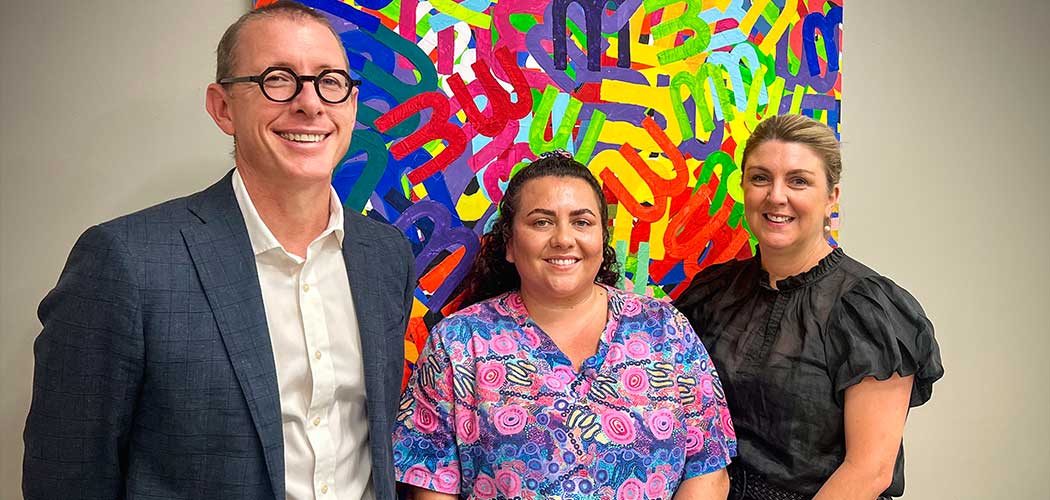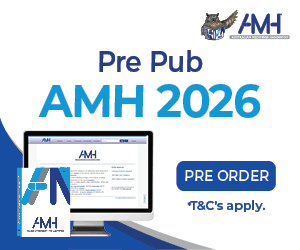This piece reflects on the experience of an Indigenous Nursing Cadetship from the perspectives of an Indigenous Nursing Cadet, a Nurse Researcher, and an Executive Director of Nursing.
There is value in the opportunity to present individual viewpoints in collaboration as the authors believe in a genuine partnership between health services and Aboriginal and Torres Strait Islander health professionals to improve health outcomes for First Nations families.
It is widely recognised that cultural determinants of health are crucial in addressing health inequities. This includes Indigenous families receiving advice from Indigenous Health professionals and feeling welcomed and culturally safe in a clinical space that respects and responds to differences. Approximately 8% of inpatients and 7% of outpatients presenting to a quaternary paediatric hospital in Queensland are children with at least one parent identifying as Aboriginal and/or Torres Strait Islander. This equates to about 100 children and young people on any given day.
Despite this, in 2020, only 1.29% of staff employed at the same hospital identified as Aboriginal and/or Torres Strait Islander. Initially, this was recognised as a key target in the organisation’s nursing workforce plan. Also, this was set as a goal in a wider health equity strategy aimed at improving recruitment and retention of Indigenous health staff across all streams. This was further supported by the appointment of inaugural Indigenous Nursing Cadets in 2021.
The cadetship program offered paid work placements in a fixed-term temporary part-time capacity for Aboriginal and Torres Strait Islander university students during full-time studies. Cadets needed to be minimum second year of studies and were required to work the equivalent of 456 hours per calendar year. They could roll the cadetship over to a second year if they are still a full-time student. Nursing cadets were employed at an Assistant in Nursing (AIN NG1) level.
The overarching goals of the cadetship program were to foster a culturally sensitive workplace, facilitate successful completion of studies, and promote the host health service as a preferred workplace for Indigenous health professionals. The cadetship aimed to facilitate and support relevant learning opportunities for the cadet within the scope of practice. It was also expected the health service would benefit from the cadet’s cultural perspective by identifying areas of improvement and ensuring culture was at the centre of strategies developed to implement change. The health service also listened to expert cultural advice and considered the need for a pipeline of opportunities for a new or existing healthcare worker to enter the workplace.
From the perspective of an Indigenous nursing cadet, the structured support within the cadetship proved instrumental to both professional and cultural development. From a nursing standpoint, the program’s framework ensured comprehensive support. The cadet benefited from guidance from their line manager and professionals across diverse nursing fields. There was also scope for the cadet to experience nursing in a variety of clinical settings and situations. This experience broadened the cadet’s understanding and facilitated strategic alignment of personal and professional goals. This collaborative approach allowed for careful planning of clinical practice, academic pursuits, and alignment with future career goals post-degree completion.
Culturally, the cadetship demonstrated foresight by providing a cultural mentor who, as a registered nurse, facilitated the navigation of challenges within the existing healthcare system. This mentor was crucial in sharing the cultural load burden, particularly when faced with intricate, complex scenarios. Even during university clinical placements, the cadet continued to receive mentorship and support, which proved invaluable in navigating challenging situations and within the clinical setting.
The impact of the cadetship extended beyond personal growth, as the cadet actively participated in building the Indigenous nursing workforce both on a state-wide level and within the host hospital. The cadet effectively advocated on behalf of themselves, patients, and their families, ensuring that healthcare considerations embraced a culturally safe, holistic, family-centred approach. An example of this involvement included a contribution to creating a vaccination education course tailored explicitly for Indigenous healthcare workers, addressing a critical gap in healthcare education.
While the cadetship undeniably fostered personal and professional growth, areas for improvement emerged, notably the limitation of the scope of practice. Addressing this limitation is crucial to enhancing the program’s overall effectiveness for future Indigenous nurses. Nevertheless, the cadetship proved instrumental in securing full-time employment and shaping a well-rounded Indigenous nurse prepared to contribute meaningfully to the healthcare sector.
The cadet was placed under the line management of a Nurse Researcher (NG7) attached to a paediatric specialist immunisation service within the hospital and health service. Together, the Nurse Researcher and the cadet identified learning goals each university semester, and with careful planning, learning opportunities were aligned with university modules. By liaising with nurse educators in relevant areas, the cadet was placed in various clinical areas throughout the health service for full or half-day supernumerary shifts. This provided exposure to different clinical scenarios and diverse patient cohorts. One limitation of the cadetship was the classification level of AIN. This prevented the cadet from practising clinical skills under appropriate supervision and within scope. The cadet was limited to observing procedures rather than applying learned skills with trained staff, which would have provided valuable learning experiences.
An advantage of the cadetship from a managerial perspective was the flexibility in rostering. The program was structured to allow the cadet to complete the total hours for the year in any combination that was mutually suitable to themselves and the health service. This meant they could work more during university breaks and flex hours during high university activity like exam periods and practical placements.
The opportunity to work with an Indigenous Nursing Cadet as a line manager and clinical supervisor has been both personally rewarding and valuable at a service level. The perspective of healthcare through an Indigenous lens was vitally important in affecting positive change, and the cadet was able to suggest ways to make the health service more inclusive and welcoming to First Nations families. This occurred informally in conversation with colleagues and formally through involvement on various boards and committees. The cadet was able to share cultural values, strengths and differences with an inherent understanding of unconscious bias, which encouraged colleagues to explore and accept cultural differences respectfully.
From the Executive Director of Nursing Services perspective, at an organisational level, students, cadets, and early career nurses bring many benefits. While their skills and knowledge are still developing, they contribute an enormous injection of positive and curious thinking that has an intangible impact on the teams they work with and the care they deliver. An Indigenous cadet amplifies this benefit with the addition of cultural knowledge and expertise, which, combined with a curious, enthusiastic new professional, is incredibly impactful. The cadetship program is also a great barometer of the cultural safety of our work environment and our nursing care delivery. As a health service that values health equity, we have tried hard to create a direct link between cadets and health service executive as we value the cadet’s cultural expertise and recognise it has helped us identify the challenges and opportunities facing health equity at our health service.
Overall, the Indigenous Nursing Cadetship program has exceeded expectations at the executive, line manager and cadet level. The program has achieved immediate goals of facilitating successful completion of studies and promoting the host health service as a preferred workplace. The Nursing Cadet achieved high university results, delivered the graduand address at their graduation ceremony, and has successfully obtained a post graduate nursing position at the same health service. The program has also contributed more widely to the long-term goals of fostering a culturally sensitive workplace and identifying areas of improvement to enhance cultural safety.
A key organisational health equity strategy priority is strengthening the Aboriginal and Torres Strait Islander workforce. The cadetship program aligns with this strategy by contributing to developing career pathways for Aboriginal and Torres Strait Islander staff and supporting their leadership, value and lived experience. By considering the feedback of our Indigenous cadets at all levels, the program also supports inclusion of Aboriginal and Torres Strait Islander staff in decision making throughout the health service.
Aboriginal and Torres Strait Islander children in Queensland still have a higher mortality rate and shorter life expectancy than non-Indigenous children. As a paediatric state-wide health service, we are committed to improving health outcomes for Aboriginal and Torres Strait Islander babies, children, young people and their families by delivering sustainable, culturally safe, and responsible healthcare. The Indigenous nursing cadet program has been an integral step in encouraging us as an organisation to listen, learn and walk on the journey together.
Conflict of interest/declaration: The authors wish to declare that no funding was received to assist with the preparation of this manuscript. The authors have no competing interests to declare that are relevant to the content of this paper, and this paper has not been submitted for consideration with any other publications.
Authors:
Rebecca Doyle, BNurs; GradCertPaedCritCareNsg; MMedRes, Nurse Researcher, Children’s Health Queensland and Adjunct Research Fellow, School of Nursing, Midwifery and Social Work, University of Queensland
Amber Wighton, BSN, Registered Nurse, Children’s Health Queensland, (Previous Indigenous Nursing Cadet)
Callan Battley, BSN, GradCertNsg; GradCertLeadership&Mgt, Executive Director of Nursing Services, Children’s Health Queensland and Adjunct Professor, School of Nursing, Midwifery and Social Work, University of Queensland









One Response
As the Indigenous Nursing/Midwifery Mentor at the University of the Sunshine Coast I had the pleasure of supporting Amber through her studies! Amber is an amazing role model and inspiration for all of our Indigenous Nursing and Midwifery students! I congratulate her on her achievements and the care, support and acknowledgement that Amber gives to our Indigenous community!